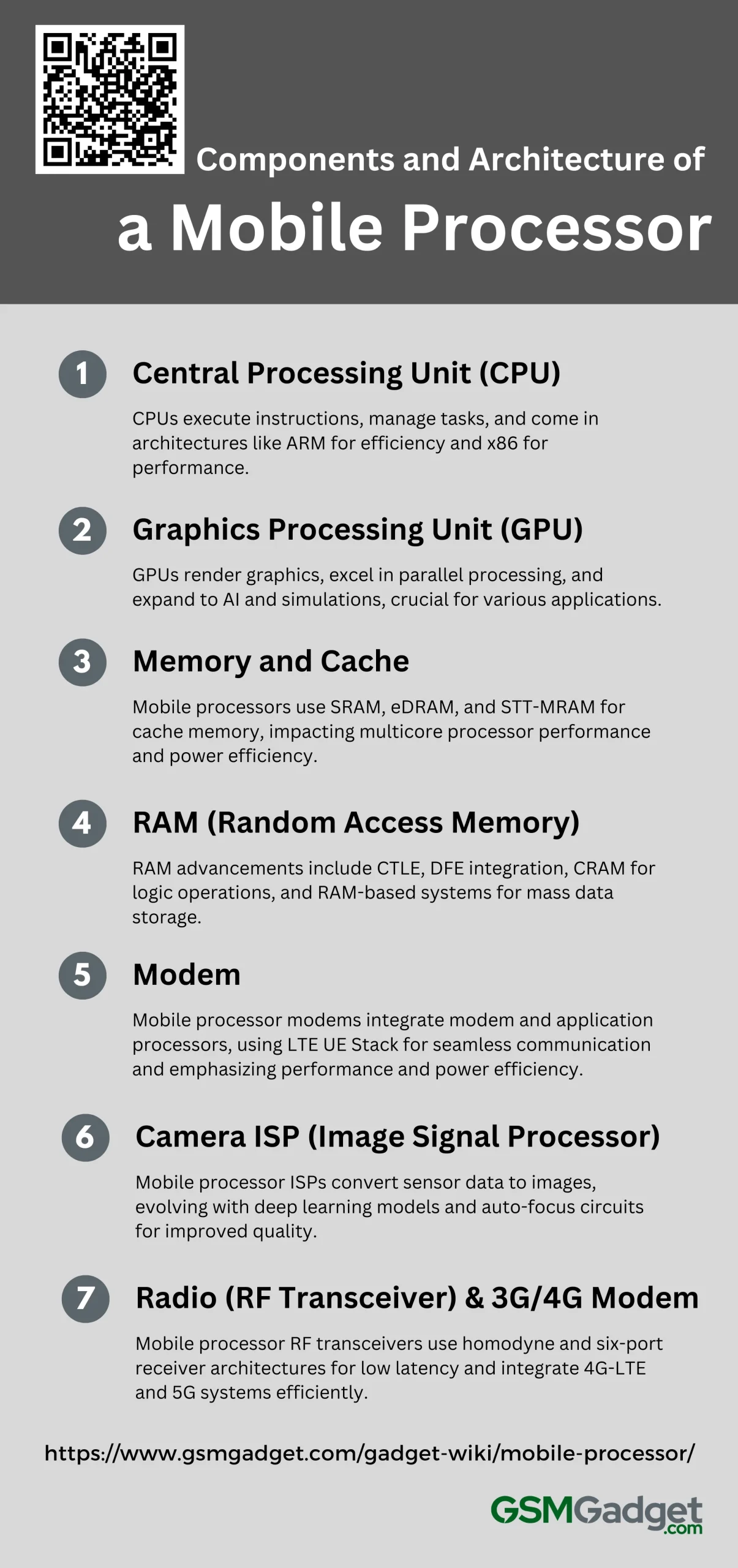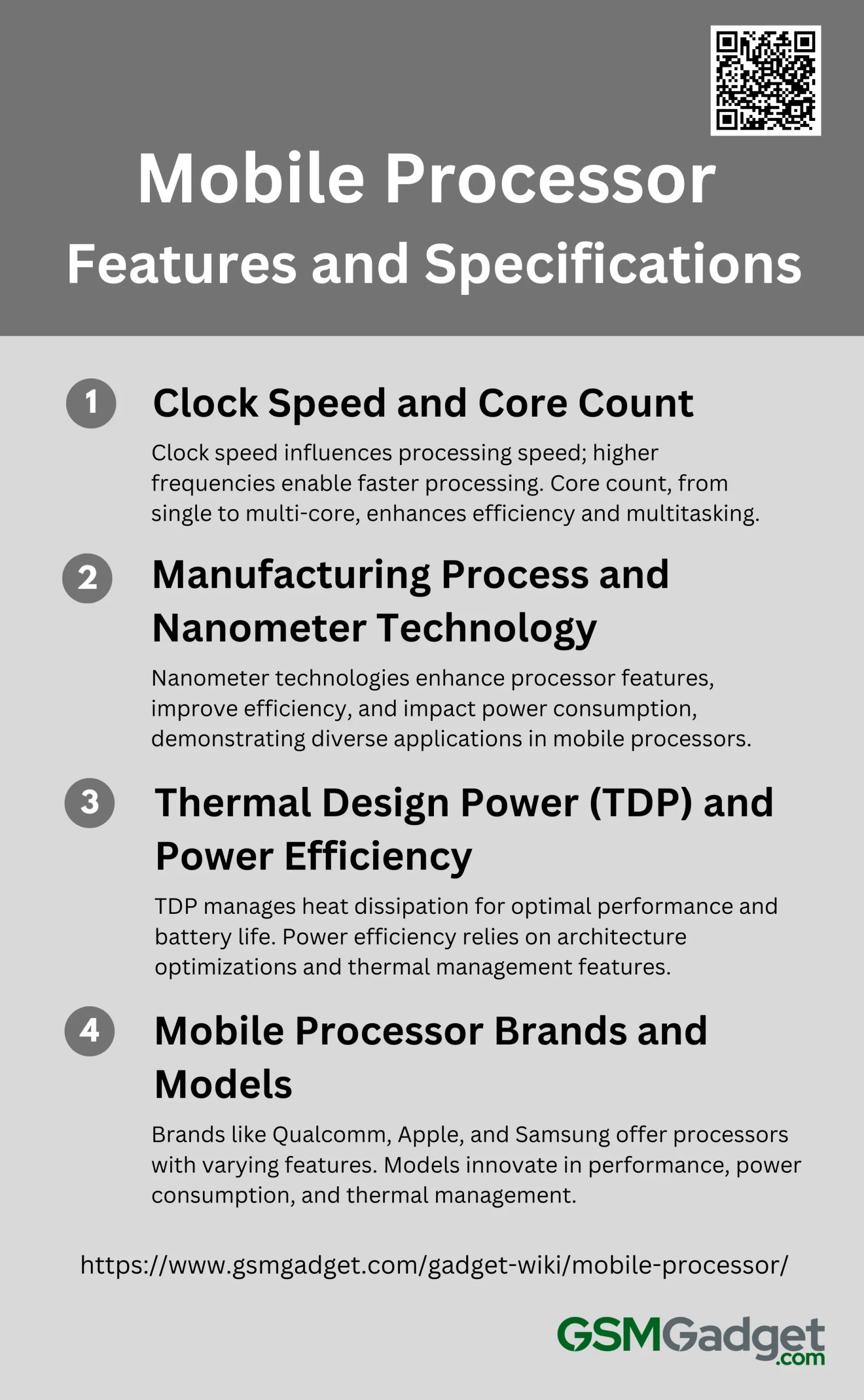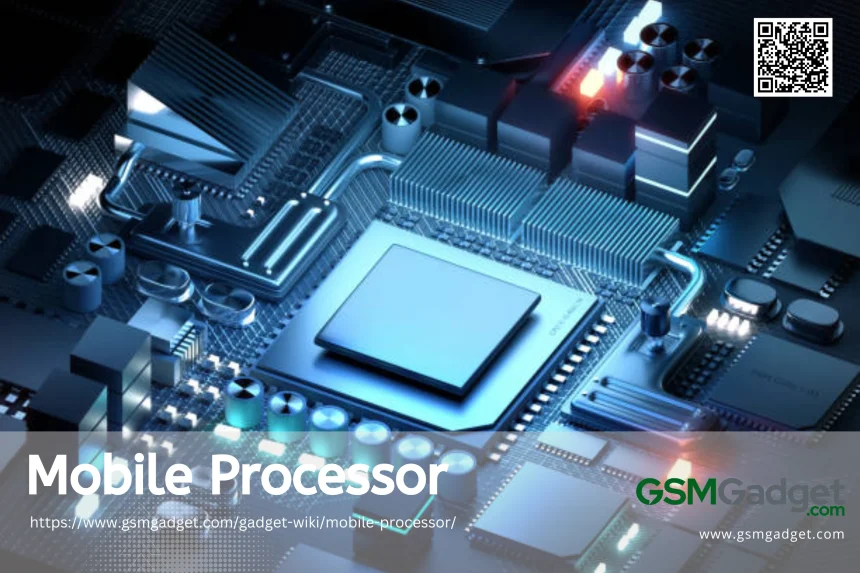A mobile processor, also known as a Central Processing Unit (CPU), is the central component of a smartphone or tablet responsible for executing commands and performing calculations at high speeds. It processes every command, impacting every running on the device, from the camera to simple email programs. The efficiency of the processor directly influences the device’s performance, making it a critical element in mobile technology. Initially, mobile phones were bulky and had limited features, only working in areas with strong connections. The integration of processors into cell phones marked a significant advancement, turning them into the essential, multifunctional devices we rely on today. The history of mobile processors mirrors the broader evolution of mobile phone technology. From their introduction in 1979 as expensive tools for business professionals to their current status as ubiquitous devices for various personal and professional tasks, processors have played a vital role. Early mobile devices focused on voice capabilities, with significant variations in size and network quality. Advancements in processor technology over time have allowed for the miniaturization and enhancement of mobile phones, supporting a wide range of applications and services. Modern mobile processors, as discussed by Lockey Aaron Benjamin and Thompson Timothy Joseph, are designed to efficiently support complex functionalities, even when integrated into a limited number of mobile device components. This design enables remote interaction with the mobile device’s interface, demonstrating the processor’s role in enabling versatile and powerful mobile computing experiences. The shift towards energy-efficient, multicore processors addresses technical challenges and changing market conditions, showcasing the continuous innovation in processor technology to meet the demands of modern mobile applications. This ongoing development emphasizes the significance of mobile processors in enhancing the capabilities and performance of smartphones and tablets, making them essential to the functionality and user experience of these devices.
Components and Architecture of a Mobile Processor
When it comes to understanding the inner workings of your smartphone, the mobile processor is a crucial component that often goes unnoticed. This tiny powerhouse is responsible for executing the myriad of tasks that make your device function smoothly. From running applications to managing connectivity, the mobile processor is the brain behind it all. In this listicle, we will delve into the components and architecture of a mobile processor, breaking down the complex technology into easily digestible points. Whether you’re a tech enthusiast or just curious about what makes your smartphone tick, this guide will provide you with a comprehensive overview of the essential elements that drive mobile performance. Let’s explore the fascinating world of mobile processors and uncover the secrets behind their efficiency and power.

1. Central Processing Unit (CPU)
A Central Processing Unit (CPU) is the primary hardware component in a computer that is responsible for executing instructions, performing arithmetic and logical operations, and managing input/output tasks. CPU architectures such as ARM and x86 are commonly found in mobile devices. ARM processors are known for their energy efficiency and are widely used in smartphones and tablets, providing a balance between performance and power consumption. In contrast, x86 processors, which are typically used in laptops and desktops, offer high performance but may consume more power compared to ARM chips. Processors in mobile devices, as described in, allow for remote interaction with a device’s user interface by executing essential functions on a limited set of components, enabling communication over networks. Understanding CPU architectures is essential for optimizing performance and power efficiency in mobile devices.
2. Graphics Processing Unit (GPU)
The Graphics Processing Unit (GPU) plays a crucial role in rendering 3D graphics and videos, making it a fundamental component in the gaming industry. With its significant parallel processing capabilities and ease of programmability, the GPU has expanded its applications beyond gaming to fields such as artificial intelligence, health data analytics, and physical simulations. The architecture and programming model of the GPU have become essential topics in parallel computing, leading to advancements in performance, energy efficiency, and reliability. As the demand for graphics applications continues to grow, the GPU’s performance is essential not only in gaming but also in multimedia applications, where its efficient handling of computing-heavy tasks is vital. This emphasizes the importance of the GPU in providing optimal visual experiences and computational power across various domains.
3. Memory and Cache
In modern mobile processors, memory technologies such as SRAM, eDRAM, and STT-MRAM play crucial roles. Cache memory, located between the central processor and main memory, significantly impacts system performance in multicore processors. Cache memory is essential for coordinating data transfer rates and enhancing processing speed, particularly as processor speeds increase rapidly. Various cache memory designs aim to reduce energy consumption, improve access times, and minimize miss rates. The design of cache memories is crucial for maintaining low miss rates, short access times, and power efficiency, although achieving these objectives simultaneously can be challenging. Additionally, concerns about cache memory security have led to more controlled designs, affecting cache performance. By utilizing innovative memory technologies and cache designs, mobile processors can achieve scalable performance improvements and energy efficiency.
4. RAM (Random Access Memory)
Random Access Memory (RAM) plays a critical role in various computing systems. Different innovations have been introduced to enhance RAM functionality. One such advancement involves incorporating a continuous-time linear equalizer (CTLE) and decision feedback equalizer (DFE) within RAM to compensate for channel gain and reduce inter-symbol interference, respectively. Additionally, methods have been developed to optimize RAM output register processing, addressing issues related to register compression and asynchronous control terminals, thereby improving RAM implementation in FPGA chips. Another significant development is the Computational Random Access Memory (CRAM), which enables logic operations within the memory array itself, enhancing computational efficiency by performing computations directly within the memory array rather than relying on external processors. Furthermore, RAM-based computer systems have been designed to operate without conventional storage devices, utilizing RAM for mass data storage and eliminating processing speed bottlenecks associated with traditional storage media.
5. Modem
A mobile processor modem typically consists of a modem processor responsible for protocol processing and a dedicated memory for efficient operation. In recent advancements, a novel architecture integrates the modem processor with an application processor on a single chip, sharing the main memory to enhance performance and reduce power consumption. The software components of a mobile terminal include modules such as boot loaders, protocol stacks, device drivers, real-time operating systems (RTOS), and general operating systems (OS) to effectively drive hardware components. The LTE User Equipment (UE) Stack plays a crucial role in mobile terminal modems, facilitating seamless communication and data exchange between the application processor and the modem protocol processor. Overall, the architecture of a mobile processor modem is evolving to meet the increasing demands of modern mobile communication services, emphasizing performance, power efficiency, and seamless connectivity.
6. Camera ISP (Image Signal Processor)
The Image Signal Processor (ISP) in a mobile processor plays a crucial role in converting raw sensor data into high-quality images captured by smartphone cameras. Traditional ISP pipelines typically include sequential modules such as demosaicing, denoising, white balancing, and color enhancement. However, these fixed architectures may restrict adaptability to various sensors, scenes, and tasks. Recent advancements suggest replacing traditional ISP algorithms with deep learning models, such as DelNet and UNet architectures, to improve image reconstruction quality and generalizability across different lighting conditions. Furthermore, innovations like auto-focus circuits integrated within the ISP further enhance image quality by ensuring continuous focus even when processing data from multiple image sensors simultaneously. The continuous development of ISP components and architectures in mobile processors demonstrates the ongoing effort to enhance imaging capabilities in modern smartphones.
7. Radio (RF Transceiver) & 3G/4G Modem
The architecture of a mobile processor’s radio frequency (RF) transceiver typically includes various key components and design considerations. In the context of next-generation mobile networks, the latency contribution of front-end architectures is crucial, with homodyne and six-port receiver architectures showing nanosecond delays, impacting ultra-high-speed RF interconnects and massive data transfers. To enable the coexistence of 4G-LTE and 5G systems in mobile devices efficiently, a radio transceiver architecture divides the front-end into two parts based on frequency bands, utilizing direct IQ modulation/demodulation blocks and frequency synthesizers for both low and high-frequency operations. Additionally, a multi-band mobile communication RF transceiver integrates baseband processing modules, RF front-end modules, and transceiver antennas for efficient signal reception and transmission across adjacent frequency bands. Moreover, impedance adjusting devices play a critical role in matching output impedances in RF transceiver circuits, ensuring optimal signal transmission and reception in mobile phone devices.
Mobile Processor Features and Specifications
Mobile processors are the heart of modern smartphones, driving everything from app performance to battery efficiency. Understanding their features and specifications can help you make an informed decision when choosing your next device. Here are some key aspects to consider:

1. Clock Speed and Core Count
Mobile processors are essential for determining the performance of devices, with clock speed playing a crucial role in influencing processing speed. Higher clock frequencies, made possible by deep sub-micron technologies, allow for faster processing and the integration of new functions. Single-core processors have one processing unit, which is suitable for basic tasks, while dual-core processors offer improved multitasking capabilities. Quad-core processors further enhance performance by dividing tasks among four cores, increasing efficiency and speed. Multi-core processors, such as those found in advanced mobile devices, integrate multiple heterogeneous or homogeneous processors onto a single chip, showcasing the next generation of communication standards and multimedia applications. However, balancing increased performance with low power consumption remains a challenge, requiring innovative low-power techniques to sustain advancements in mobile processing.
2. Manufacturing Process and Nanometer Technology
The manufacturing processes of various nanometer technologies play a crucial role in enhancing the features and specifications of mobile processors. For example, the development of nanometer far-infrared negative ion electrothermal films and nanometer materials through atomization contribute to the efficiency of mobile processors. These processes involve precise steps such as atomization of liquid precursors and plasma generation to produce powder nanometer materials. The use of wear-resistant nanometer thermal insulation films and nanometer mineral energy modification agents in down jackets demonstrates the diverse applications of nanometer technologies. The integration of smaller nanometer technologies in mobile processors significantly impacts power efficiency and performance by improving heat dissipation, reducing indoor temperatures, and enhancing infrared blocking rates, ultimately leading to improved overall efficiency and functionality.
3. Thermal Design Power (TDP) and Power Efficiency
The Thermal Design Power (TDP) of mobile processors is a critical factor in managing power consumption and heat dissipation. TDP represents the maximum amount of heat generated by a processor that the cooling system must dissipate. Efficient TDP management is essential for maintaining optimal performance without overheating, as various temperature constraints interact with thermal characteristics to limit die temperature and CPU frequency. Power efficiency is crucial for extending battery life in mobile devices, particularly with the increasing power requirements of high-performance processors. Architecture-level optimizations, such as utilizing dynamic critical path information and compiler optimizations, are important strategies for addressing power challenges while ensuring high performance and prolonged battery life. Incorporating thermal management features like thermal inserts, graphite strips, and thermal spreaders can further enhance power efficiency by redirecting thermal energy away from critical components.
4. Mobile Processor Brands and Models
Mobile processors play a crucial role in the performance and efficiency of smartphones. Various brands such as Qualcomm, Apple, and Samsung are prominent in this field. For example, models like the Qualcomm Snapdragon 778G+, Exynos 1280, and HiSilicon Kirin 980 are notable for their ARM 64-bit processors, each excelling in different aspects such as performance, power consumption, and temperature management. Innovative approaches like the low-power graph convolutional network (GCN) processor have also been proposed to accelerate 3D point cloud semantic segmentation (PCSS) in real-time on mobile devices, demonstrating advancements in power-efficient processing. These advancements underscore the ongoing evolution of mobile processors, with a focus on improving performance, reducing power consumption, and optimizing thermal management across various devices and generations.
